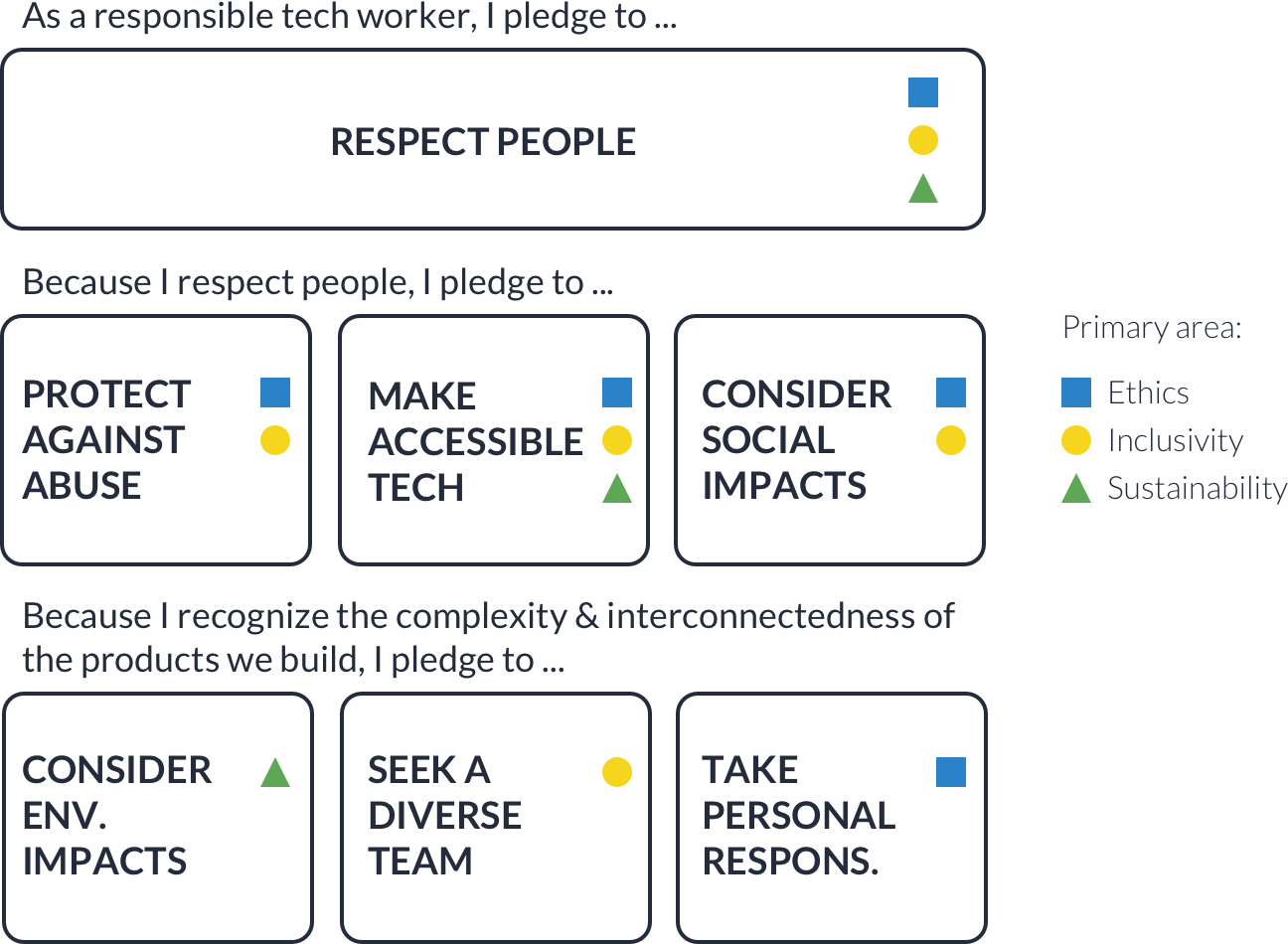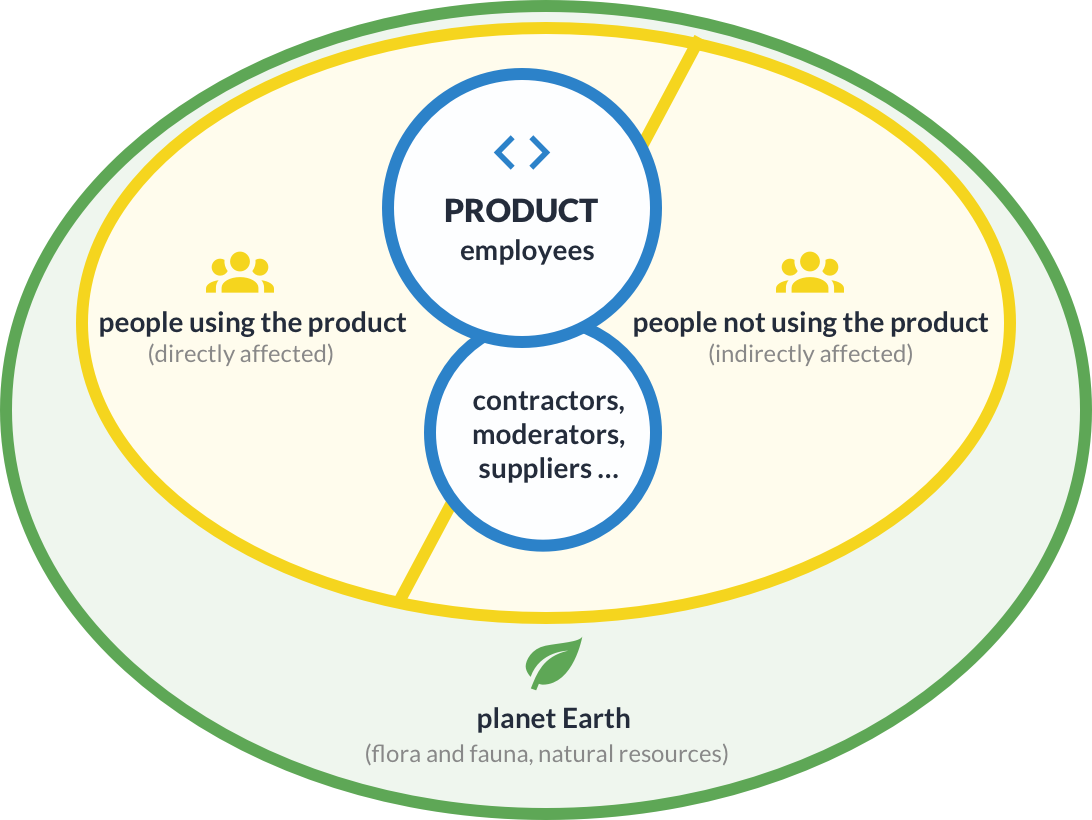The ResponsibleTech.Work framework proposes practical tools for more responsible product development in the tech industry based on core guiding principles.
It is a practical and open-source framework developed by tech workers for tech workers, using research insights from a wide range of disciplines. (Learn how to contribute.)
Our goal is to help all tech workers develop, design, and modify products and features to be more safe, inclusive, and sustainable and help tech founders and decision-makers make informed decisions on whether a new product or feature should be built by factoring the social and planetary costs of product innovation and development.

Core elements of the framework
The framework has three core elements, from the more abstract to the more concrete:
- The Pledges: guiding principles and pledges for tech workers; the goal is to inspire individuals to learn about key issues by providing starting discussion and action points.
- Methodologies: guidelines on how to innovate and develop more responsible products; the goal is to evolve processes within companies.
- Tools: implementing the principles in practice; the goal is to help all tech workers act more responsibly every day.
The Pledges: guiding principles and pledges for tech workers
The ResponsibleTech.Work framework aims to define responsible product development as a combination of ethics, inclusivity, and sustainability and to acknowledge the complexity and interconnectedness of responsible product development using systems thinking.
For the core overarching principle, we chose respect for people, from which we can derive six additional principles that cover all three core areas of impact:

The framework aims to consider the systemic impact of product development by asking the following core questions:
- How is it made: is it fair to those who make it, and are the various impacts considered during the development?
- How is it used: how might it be (ab)used in ways we did not anticipate?
- How does it affect people: how might it hurt people (even those not using the product), and how is it changing society?
- Is it sustainable for the planet: what is the environmental cost?

7 Think + Act pledges
To make the core principles and interconnectedness of systems more tangible, the framework offers seven core pledges. Each pledge includes:
- a list of issues to think about and discuss with colleagues and
- a list of concrete suggested actions you can take as a tech worker.
This is how each pledge provides guidance on both how to think & act on the core principles to inspire change. Further change can then be implemented by managers and decision-makers by evolving methodologies or by individual tech workers and teams by using one of the practical tools.
Methodologies: innovating and developing responsible products
Currently, most innovation methodologies for developing new products and businesses don’t pay special attention to responsible product development. Methodologies like the Lean Startup focus on product/market fit regardless of the effects the new product will have on people and the planet outside the narrow scope of the chosen business model. The social and environmental costs of innovation and new products aren’t an important part of popular innovation and business methodologies, if they are mentioned at all.
This is why the framework also aims to improve popular innovation methodologies used in various phases of the innovation and development processes. Existing methodologies can be updated by surfacing important aspects from the fields of ethics, inclusivity, and sustainability.
Tools: implementing principles in practice
To see meaningful change, we must implement responsible development principles in our day-to-day work. By updating familiar tools, we bring in greater awareness of ethics, inclusivity, sustainability, and systemic interconnectedness at various decision points in the design and development process.
The following requirements should be taken into account when proposing new tools for the framework:
- Make it easy to modify existing processes: A tool is only valuable if used, so the suggested tools should be familiar enough to facilitate adoption. We must recognize that working on the proposed principles isn’t comfortable, which is why slight adjustments to existing processes will likely be accepted with less resistance than an entirely new way of working. A need for new approaches might emerge eventually, but existing tools and processes can be a good starting point.
- Make it clear at which stage and how often each tool is used: Some discussions need to be had before development kicks off, while a different type of guidance is also needed as the product evolves with previously unplanned functionality and as you encounter unplanned usages. Use language familiar to software developers, designers, product owners, etc. Again, the goal is to facilitate adoption by introducing new mental models in a familiar way.
- Make it open source: All framework assumptions, core principles, and the resulting tools should be questioned and analyzed through a diverse lens. The framework isn’t owned by a single person or organization. Everyone can contribute new tools and suggest changes as long as they align with the defined framework values and goals.
- Make it useful and applicable even for small, scrappy teams with a small budget, tight deadlines, and lacking specialists: Ideally, as the company grows and gets funding, it can hire and include ethics, accessibility, sustainability, and other specialists into product teams but emerging startups need tools they can use with limited funding.
- Make it easy to scale as the team size and scope grows: Consideration should be given to how manageable the tools are as the product team grows and even branches into different products and product teams.
- Some ethical discussion is always better than none; done is better than perfect: Given the other requirements, the tools might not be able to go super deep, but the key is to include at least some aspects of ethics, inclusivity, and sustainability into development at the earliest possible stages.
